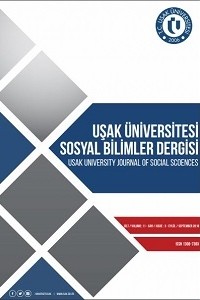FED POLİTİKALARININ EMTİA FİYATLARINDAKİ OYNAKLIĞA ETKİSİ
Bu çalışmanın amacı Amerikan Merkez Bankası (Fed) para politikalarının emtia fiyatlarındaki oynaklığa etkisini araştırmaktır. Bankanın sıkılaşma döngüsü aşırı ısınan ekonomiyi yavaşlatmayı ve enflasyonu frenlemeye yönelik bir para politikasıdır. Daraltıcı para politikası emtia fiyatlarındaki oynaklığı etkilemektedir. Bu çalışmada bu etkiyi görmek için Fed’in faiz artırımı öncesi ve sonrasında altın, petrol ve Bloomberg Emtia Endeks fiyatlarından elde edilen günlük getiriler kullanılmıştır. Çalışma dönemi olarak 02.08.2021 ve 31.10.2022 arası dönem alınmıştır. Veri seti 16.03.2022 tarihli Fed faiz artırımının öncesi ve sonrası olmak üzere ikiye bölünmüştür. Çalışmada asimetrik etkiyi de inceleyen Üssel Genelleştirilmiş Otoregresif Koşullu Değişen Varyans Modeli kullanılmıştır. Fed faiz artırımı öncesi petrol fiyatlarında geçmiş dönem oynaklık şoklarının etkisi mevcutken bu etki faiz artırımları sonrası mevcut değildir. Altın fiyatları faiz artırımı öncesinde geçmiş dönem şoklarından etkilenmektedir. Faiz artırımı ile altın getirilerine göre diğer emtia getirilerinin daha oynak hale geldiği gözlemlenmiştir.
Anahtar Kelimeler:
Fed Para Politikaları, Emtia Fiyatları, Oynaklık
Keywords:
Fed Para Politikaları, Emtia Fiyatları, Oynaklık,
___
- Amatov, A. ve Dorfman, J. H. (2017). “The Effects on Commodity Prices of Extraordinary Monetary Policy”, Journal of Agricultural and Applied Economics, 49(1), 83-96.
- Anaya, P., Hachula, M., ve Offermanns, C. J. (2017). “Spillovers of U.S. Unconventional Monetary Policy to Emerging Markets: The Role of Capital Flows”, Journal of International Money and Finance, 73, 275–295.
- Anzuini, A., Lombardi, M. J., ve Pagano, P. (2013). “The impact of Monetary Policy Shocks on Commodity Prices”, International Journal of Central Banking, 9(3), 119-144.
- Baek, J. ve Miljkovic, D. (2018). “Monetary Policy and Overshooting of Oil Prices in an Open Economy”, The Quarterly Review of Economics and Finance, 70, 1-5.
- Bakas D. ve Triantafyllou, A. (2019). “Volatility Forecasting in Commodity Markets Using Macro Uncertainty”, Energy Economics, 81, 79-94.
- Bernanke, B.S., Gertler, M., Watson, M., Sims, C.A. ve Friedman, B.S. (1997). “Systematic Monetary Policy and the Effects of Oil Price Shocks”, Brookings Papers on Economic Activity, 1997(1), 91-157.
- Black, F. (1976). “Studies of Stock Price Volatility Changes”. In Proceedings of the 1976 Meeting of the Business and Economic Statistics Section, 177–181. American Statistical Association.
- Bollerslev, T. (1986). “Generalized Autoregressive Conditional Heteroscedasticity”, Journal of Econometrics, 31, 307–27.
- Borensztein, E. ve Reinhart, M. C. (1994). “The Macroeconomic Determinants of Commodity Priees”, IMF Staff Papers, 41(2), 236-261.
- Bowman, D., Londono, J. M., ve Sapriza, H. (2015).” U.S. Unconventional Monetary Policy and Transmission to Emerging Market Economies”, Journal of International Monetary and Finance, 55, 27-59.
- Dickey, D. A. ve Fuller, W. A. (1979). “Distribution of the Estimators for Autoregressive Time Series with a Unit Root”, Journal of the American Statistical Association, 74 (366), 427-431.
- Diaz, J. D., Hansen, E. ve Cabrera, G. (2021). “Economic Drivers of Commodity Volatility: The Case of Copper”, Resources Policy, 73, 1-12.
- Engle, R.F. (1982). “Autoregressive Conditional Heteroskedasticity with Estimates of the Variance of U.K. Inflation”, Econometrica, 50, 987–1008.
- Ferderer, J. P. (1996). “Oil Price Volatility and the Macroeconomy”, Journal of Macroeconomics, 18(1), 1-26.
- Frankel, J. A. (1984). “Commodity Prices and Money: Lessons from International Finance”, American Journal of Agricultural Economics 66 (5): 560–566.
- Frankel, J. A. (2006). “The Effect of Monetary Policy on Real Commodity Prices”, NBER WP No. 12713.
- Glick, R. ve Leduc, S. (2012). “Central Bank Announcements of Asset Purchases and the Impact on Global Financial and Commodity Markets”, Journal of International Money and Finance, 31, 2078-2101.
- Gün, M. (2020). “Investigating The Exchange Rate Volatility by Linear And Nonlinear Models”, İstanbul Commerce University Journal of Social Sciences, 39(3), 952-974.
- Kwiatkowski, D., Phillips, P.C.B., Schmidt, P. & Shin, Y. (1992). “Testing the Null Hypothesis of Stationarity Against the Alternative of a Unit Root: How Sure Are We That Economic Time Series Have a Unit Root?”, Journal of Econometrics, 54, 159–178.
- Killian, L. ve Lewis, L. T. (2011). “Does the FED Respond to Oil Price Shocks”, The Economic Journal, 121(555), 1047-1072.
- Ljung, G.M., Box, G.E.P., (1978). “On a Measure of Lack of Fit in Time Series Models”, Biometrika, 65, 297-303.
- Namini, S. S. (2021). “U.S. Monetary Policy and Commodity Prices:A SVECM Approach”, Economıc Papers, 40 (4), 288-312.
- Nelson, D.B. (1991) “Conditional Heteroskedasticity in Asset Returns: A New Approach”, Econometrica, 59: 347-370.
- Qian, Y., Ralescu, D. A. ve Zhang, B. (2019). “The Analysis of Factors Affecting Global Gold Price”, Resources Policy, 64, 101-478.
- Phillips, P.C.B. & Perron, P. (1988). “Testing for a Unit Root in Time Series Regressions”, Biometrika, 75, 335–346.
- Yao, W.& Alexiou. C. (2022). “Exploring the transmission mechanism of speculative and inventory arbitrage activity to commodity price volatility. Novel evidence for the US economy”, International Review of Financial Analysis, 80, 1-19.
- Zhu, Y., Fan, J. ve Tucker, J. (2018). “The Impact of Monetary Policy on Gold Price Dynamics”, Research in International Business and Finance, 44, 319-331.
- ISSN: 1308-738X
- Başlangıç: 2015
- Yayıncı: Uşak Üniversitesi
Sayıdaki Diğer Makaleler
DÜŞÜK KALİTELİ VE KESİM ATIĞI DERİLERDEN İLERİ DÖNÜŞÜM GİYSİ TASARIMI ÖNERİLERİ
ONTOLOJİ ÜZERİNE BİR DENEME MEVLÂNÂ ÖRNEĞİ
FED POLİTİKALARININ EMTİA FİYATLARINDAKİ OYNAKLIĞA ETKİSİ
SOSYAL MEDYADA INFLUENCER ETKİSİ BAĞLAMINDA BENLİK SUNUMU
Bilal Erkan DEĞER, Rengim SİNE NAZLI
ŞE‘ARA FİİLİ VE KUR’ÂN’DAKİ İŞTİKÂKLARI
İbrahim KOCABIYIK, Natıq Fawzı Ibrahım AL-AZZAWI
